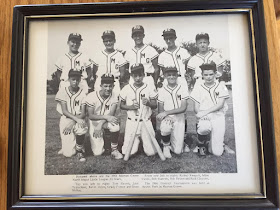We posted this just short of half-century old nostalgic photo on my personal Facebook page back in 2011. We were reminded of it the last few days when a couple of my childhood friends somehow ferreted it out from among my hundreds of pictures posted, and clicked the Like button. It occurred to me that some among the broader audience of current and former Morton Grove residents who read my blog might find the photo of interest. Now the pictured individuals will have an opportunity to turn up in search engine results.Sure enough, through the magic up the internet, I heard a couple of weeks back from a pictured teammate, Rich Kengott. Rich shared his copy of the team photo, which includes a contemporaneous caption identifying the players.
Rich also sent a picture of the back side of the framed photo, which has my father's name and the address of the home I was raised in from 1953 to 1971.
Thanks to Dad for kindly distributing this framed piece of memorabilia to each of the players on the 1966 team.
I can see now the earlier post erroneously identified the fellow holding the crossed bats as Rich Lauson. We know now that was Bob Warren. I will correct it.
Our ties went beyond baseball. Rich and I started caddying together at Glen View Club in September 1964. Each caddie was assigned a number. But that first fall we did not get our own number as we were kind of like late season baseball farm system call ups who had not earned a permanent job. We caddied on our brother's caddie numbers. I recollect my number was 118a and Rich's number was number "a" something or other too, caddying off of his brother Ray's number, if I recollect his older brother's name correctly.
Bless Rich for keeping the caddie badges which issued with his numbers from six out of our first seven full years. I remember the first year his number was 147 and mine was 145, mine lower probably because my first loop was a few days earlier than his the previous fall. Each year thereafter, my number was one lower than Rich's because whoever had been assigned 146 in year one fell out of the program
My numbers were 145 in 1965, 94 in 1966, 68 in 1967, 39 in 1968, 12 in 1970 and 10 in 1971. Rich's year 1969 badge is missing, but I recall I was something like number 19, which would have made him 20. If memory serves me right I was number 2 caddying weekends while working a factory job in 1972.
Rich kept detailed records on caddie pay.
Here is some clarification on the caddie pay.1966 caddie badge # 95 earned July 5, 3.50 a bag and by Aug 9, 4.75 a bag; 1967 caddie badge #69 earned July 5, 4.75 a bag and Aug 5, 9.50 doubles; 1968 caddie badge #40 earned July 4, 9.50 doubles and July 21 and the rest of the year 10.50 doubles; 1969 caddie badge #13? I think it was in the 20’s, earned July 4, 10.50 doubles all year.
I remember taking the Skokie Swift down to the Howard Street L with Bob Casey to attend a Cubs game in 1967. Bob was kind of baby faced. He wanted to save 50 cents or whatever the fare difference was by paying the youth fare (age 12 and under). The CTA attendant asked what Bob's birthday was. He replied with a month and date late in the year. The attendant asked what year. Bob replied 1953. Bob paid the adult fare.I stopped recording after 1969. I continued to caddy for a few more years but also found a factory job with my best friend Bob Casey. We worked the next six summers for his neighbor Bob Palka at Detex Corporation in Chicago.
Here are a couple of pages from Rich's 1966 hard copy caddie record.
The $2.00 entries are for 9-hole loops. Back in the day we earned "winter" pay early and late in the year, which meant $4.00 (instead of $3.50) a bag for 18 holes and $2.00 (instead of $1.75) a bag for nine holes. Five of the nine dates in April were on weekends, two were on Fridays, and two were mid-week. We caddied after school when we could. The Catholic school kids were released earlier than us public school students and could parlay that into better after school earnings. Most of the caddies attended St. Martha's school in Morton Grove or Notre Dame High School in Niles.
By the end of the golf season Rich was carrying doubles most of the time and was earning $4.75 a bag for 18 holes. Rich's records definitively identify 1966 as the caddie strike year (check this link for the story of that three and one-half hour work stoppage), indicated by the large (from $3.50 to $4.75 or 35 percent) increase in pay. For the year his earnings were $737.10 ($5,394.28 in 2016 dollars), not bad for a 13-year old kid in 1966. Spring, summer and fall of 1966, baseball and caddying, earning and saving money, finishing junior high and getting ready for high school -- it was a very busy and eventful time.





No comments:
Post a Comment